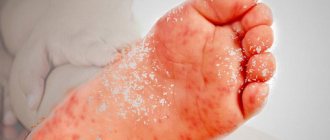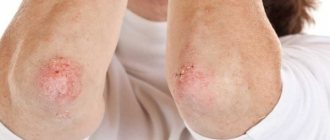Itching and red pimples on the ankles can be the result of a banal mosquito bite, but sometimes they indicate malfunctions and pathological processes in the body. Rash on the ankles manifests itself in different ways. These may be small papules, blisters, plaques, or red spots. Most often, such appearances cause discomfort, itching and itching.
To make an accurate diagnosis and prescribe appropriate therapy, you should see a specialist, but it is worth having an idea about the possible causes of such symptoms.
Household reasons
Red rash after shaving
Often, rashes are not a symptom of a disease at all, but a consequence of external influences.
A rash on the ankles may occur as a response to frequent hair removal and depilation procedures:
- allergy to depilatory products (wax, sugar paste components, etc.);
- irritation from frequent mechanical impacts from a razor.
Rashes in the form of reddish dots that itch can be easily eliminated with the help of traditional medicine or using special gels that soothe the skin.
Particularly sensitive skin may react by developing dryness and irritation on the fabrics used to make clothes or underwear (tights, stockings), shoes. This reaction can occur both in winter and in summer, when the edges of trousers or a long skirt come into contact with the skin of the ankles.
Another reason is insect attack. Bites from crawling and flying insects damage the skin and lead to itching and scratching.
In addition, there is an allergy to the liquid released into the wound by many bloodsuckers; by scratching the skin at the site of the bite on the legs, the person himself introduces germs and infection, sometimes causing a rash on the ankle that itches.
What is gout on men's legs?
Gout, as a rule, has a chronic course, so it is almost impossible to completely cure it. This disease occurs more often on the legs. In men, gout is characterized by the following symptoms:
- Acute pain in the joints, worsening in the morning;
- Redness and swelling of the first finger;
- Stiffness in the limbs;
- Limited mobility;
- Increased blood pressure;
- Increased body temperature;
- Feeling hot;
- Loss of appetite;
- Frequent mood changes.
The first attacks of gouty arthritis (inflammation of one joint) are almost always short-lived. This attack begins suddenly, usually at night. Most often, the joint of the big toe becomes inflamed (maybe one or both).
Photo: gout on a man’s big toe
In addition to the fact that patients experience severe pain, during an attack the joint begins to swell, turn red, the skin in this area becomes bright red or purplish, warm or hot to the touch. Even a slight touch to the inflamed area or minimal movement in the joint causes unbearable pain. After several days of excruciating pain (3-4 days), the symptoms suddenly stop, as if nothing had happened.
However, after a certain amount of time, the pain also suddenly returns. Moreover, if at the beginning the intervals between attacks were quite long (from one month to a year), and the attacks of gouty arthritis themselves were short-lived, then over time the clinical picture changes for the worse. Attacks become longer and the intervals between them shorter.
Eventually, a moment comes when the pain in the joints is constant, and the light intervals between attacks practically disappear. This condition is called “status gouty,” or chronic gouty arthritis. In chronic gouty arthritis, destruction of articular cartilage occurs, and specific defects are formed in nearby bones - “punches”, which are a cavity filled with microcrystals of sodium urate.
In the photo there is a symptom of a “punch” on the bone of the first toe
Sodium urate crystals may also accumulate under the skin, forming whitish, hard nodules (tophi) that are filled with a pasty mass. These tophi often form around the affected joint.
Photo: tophi around the toe joints
In especially advanced situations, gout can cause complications on the kidneys, since urates can also be deposited in them, which leads to urolithiasis and sometimes to pyelonephritis (inflammation of the kidneys).
In men, gout occurs much more often and at an earlier age than in women. The male half of humanity is susceptible to this pathology by the age of 40.
Infection and fungus
Erysipelas
There are infectious diseases, a sign of which can be a rash on the ankles, which most often itches.
- Inflammation erysipelas is localized on the leg, specifically on the lower leg. It appears as red rashes. The name comes from the French ruge - red. External manifestations resemble spots (erythema) with fairly clear boundaries of a reddish color. A few days after they appear, they peel off. There is itching, burning, pain in the area of redness and a feeling of skin tightness. The disease is accompanied by general symptoms: chills and high fever, weakness, sometimes nausea and vomiting.
- Mycosis is a disease caused by a fungus. The rash most often appears on the foot and ankle, red in color, similar to ulcers. They are very painful and peel off over time.
- Scabies mite. A small subcutaneous parasite that causes a rash and severe itching on the skin where it lives. Dotted pimples appear on your ankles or other places on your body, causing an irresistible urge to scratch them.
It is customary to distinguish between enanthema and exanthema. Enanthema is the name of a symptom, a rash of various origins (infectious, allergic and other nature) on human skin.
Exanthema is a rash on the mucous membranes and even the surface of internal organs. The same factors provoke enanthem.
Insect bites
This reason may seem unlikely, and completely in vain. Sometimes rashes on the ankles turn out to be traces of insect bites. Possible representatives include:
- fleas;
- bedbugs;
- scabies mites;
- mosquitoes;
- linen lice.
Moreover, sometimes it is not possible to detect the insect immediately. Sometimes the reason for this is the smallest size of the parasite, sometimes additional damage to the skin caused primarily by scratching.
Typically, insect bites cause severe itching. A person scratches his skin, including involuntarily, for example, during sleep. As a result, scratches, swelling, abrasions, etc. are formed. Your ankles may become swollen, making it even more difficult to determine the cause. It should be noted that some parasites, such as linen lice, mites, etc. They are equally active at any time of the year and can get on the skin of the ankles in the most unexpected way, including with recently purchased items of clothing and shoes.
Allergies as a cause of rashes on ankles
Allergic rash on the ankles
A rash on the ankles in adults and children sometimes appears as a skin reaction to an allergen. An allergic reaction can be caused by a food product or an external pathogen. A rash of allergic origin looks like urticaria: in the form of blisters, similar to a nettle burn.
In children, food allergies are more common with skin manifestations in the form of rashes and itching on the face, arms, and legs. Adults can also have a reaction to household chemicals: washing and detergents, skin care products.
In pursuit of a beautiful tan, people prone to allergies may get a red rash on their ankles instead of the desired skin tone as an allergic reaction.
An allergic rash on the legs can be provoked by close contact with pets whose fur and saliva are allergens.
Non-infectious causes
Sometimes a rash on the ankles appears as a result of skin irritation. For example, if a certain area gets exposed to household chemicals or detergents that were not removed in a timely manner or were not completely washed off, a red rash may appear in that area. The same reaction can be caused by components of washing powder or fabric softener used when washing clothes, in this case socks. Under conditions of friction and excessive sweating, the ankle in the area of contact with the fabric of the sock reacts to the allergen, becoming covered in a rash. In this case, moderate itching may occur.
To speed up the process of restoration of the skin in this case, you should provide it with careful care. To do this you need:
- remove socks, thereby stopping further skin contact with the irritant;
- wash your feet thoroughly and rinse them with plenty of water;
- treat the skin with an antiseptic solution or chamomile infusion;
- wipe your feet dry by dabbing them with a towel;
- leave the skin open for as long as possible.
Such care of the affected area 1 - 2 times a day will eliminate the unpleasant symptom within two to three days. If, despite all the measures taken, the rash not only does not go away, but, on the contrary, gets worse, then the situation requires professional intervention and consultation with a dermatologist.
Systemic diseases
Rashes on the skin of the legs are a symptom of some serious pathologies of the most important organs and systems of the human body. A description of pathologies accompanied by itchy skin and rashes on the legs and their clinical manifestations are given in the table below.
| Name of the disease | Skin manifestations | Possible complications |
| Thrombophlebitis (pathology of the blood vessels of the legs) | Inflammation of the veins of the lower extremities manifests itself in the form of a clear venous pattern with a bluish tint. They become denser to the touch and become very itchy and itchy. | Thrombophlebitis is dangerous because a detached blood clot can travel through the bloodstream to the heart muscle, brain and lead to death. |
| Diabetes | The rash can cover the legs and any part of the body. Such rashes bring a lot of discomfort, they itch and itch. | The disease requires careful diagnosis and constant monitoring, competent systemic treatment. Skin manifestations can be relieved using topical medications. |
| Allergic purpura | Redness and induration can appear on the lower extremities (most often) and on any part of the body. | The disease is dangerous due to its complications. It can affect joints, kidneys and other important organs and systems. |
| Graves' disease (pathological process in the thyroid gland) | The capillaries of the lower extremities dilate. Reddish spots and swelling appear on the skin. | Cure from the disease completely relieves skin manifestations. |
Infectious causes
First of all, we are talking about fungal infections. Quite often, the fungus gets on the feet. The reason for this is the simplest access path. Infection can occur when the foot comes into contact with the floor surface (for example, in a bathhouse, swimming pool), someone else's shoes, even on the beach. Of course, the fungus primarily affects the space between the toes and the surface of the foot, but in some cases it can spread to the skin of the ankle.
Characteristic signs of fungal infection make it possible to identify an infection in the early stages. Symptoms of such diseases include:
- red spots;
- the skin between the toes is cracking;
- peeling skin on the feet;
- brown rash;
- itching;
- formation of papules (sometimes).
Such rashes on the ankles of the feet can only be eliminated through appropriate treatment. Most often, in this case, antifungal agents for external use in the form of ointments are prescribed, but systemic drugs can also be used, especially if the disease is acute or chronic. It should also be remembered that fungal infections are very contagious, so precautions must be taken to prevent the spread of the disease, including to healthy areas of the skin.
Correct treatment
Naturally, a rash on the legs needs timely and proper treatment. In case of allergic dermatitis, contact with the active allergen (which, first of all, is detected) must be excluded. It is possible to prescribe the correct diet and follow a normal regimen. For example, doctors do not recommend consuming foods containing nickel.
For dry skin on the feet, salicylic petroleum jelly is usually prescribed, which is applied to the feet three times a day. In case of swelling, you will need lotions, as well as special baths made with boric acid. Antihistamines, such as Telfast, Zyrtec, Suprastin, and so on, can also be used during therapeutic procedures. It should be noted that hormonal ointments that act locally are often used.
Publication date: 2018-02-07
Methods for diagnosing skin diseases:
- Diagnosis of skin diseases
- Diagnosis of skin diseases at home
- Diagnosis of allergic skin diseases
- Diagnosis of bacterial skin diseases
- Diagnosis of viral skin diseases
- Diagnosis of hair diseases
- Diagnosis of nail diseases
- Diagnosis of skin tumors
- Skin scraping
- Blisters on the skin
- Dermatoscopy
- Demodex tests
- Diagnosis of sexually transmitted infections
- Mushroom tests
- Skin scraping
Causes of rashes
In fact, there can be a large number of reasons. For example, sometimes rashes occur due to mechanical stress when tight or uncomfortable shoes are used. As a result, the legs become red and chafed. Sometimes a rash appears after depilation.
A rash may appear after an insect bite. As a result, the person feels itching and begins to scratch the wound vigorously. Thus, some kind of infection may occur. When ticks bite, a hemorrhagic rash may well appear.
Another common cause may be a fungus. For example, mycosis refers to a rash on the feet due to parasitic fungi. The onset of such a disease is associated with the appearance of a watery rash and some cracks that appear among the toes. Then the skin particles begin to peel off and even purulent ulcers appear where there were initially blisters.
If we are talking about scabies, the rash is accompanied by severe itching. This happens because the scabies mite moves under the skin. When there is lichen, blisters may also appear.
When a rash is caused by allergic reactions, it is often associated with the use of cosmetics or certain detergents that have an allergenic effect. Reactions can be caused by fur, for example. Itching occurs due to dust mites and bed bugs. Food allergies caused by citrus fruits, chocolate, dairy products and so on are common.
Finally, we should not forget about urticaria as a possible cause of rashes. In this case, the rash may appear and then appear. Subsequently, the rashes become blisters - almost the same as those that can occur if a person is burned by nettles.
Doctors pay considerable attention to the hereditary causes of the rash. It could be eczema, for example. It usually causes bubbles containing liquid inside. Then they begin to burst and are replaced with dry crusts.
During diabetes, there may be itchy skin along with a rash on the legs. If normal blood sugar levels are restored and stabilized, the rash usually disappears.
Common symptoms and manipulations in dermatology:
- Skin rashes
- Calling a dermatologist to your home
- Itching in the urethra
- Itchy skin
- Skin rash
- Prevention of casual sex
- Skin neoplasms
- Pyoderma
- Pityriasis rosea
- Streptoderma
- Scabies
- Peeling skin
- Fungal infections
- Skin infection
- Pus on the skin
- Blisters on the skin
- Papillomas on the foreskin
- Sexually transmitted diseases
- Skin structure









